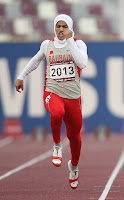'Tis the season for trotting out predictions, reflecting on the past year and wondering exactly how current players, teams, athletes, conflicts, etc. will play out.
In other words there are no shortage of sports writers (and others) playing Nostradamus and patting themselves on the back for how well they did as Oracle of 2007.
I am not going to do that. [Well a little bit I am.] Mostly I am going to comment on what everyone else thinks will happen because it's easier to critique than to come up with some grand predictions on my own. (It's lazy, I know. But I have ^%$# to get done this break.)
In the International Herald Tribune, Christopher Clarey has some thoughts on tennis and the Olympics and some other things that I don't much care about. Calling himself a "sports visionary"--tongue-in-cheek one would hope--Clarey notes that the new surface at this year's Australian Open will hurt defending champs Serena Williams and Roger Federer. Mostly I think the new surface (which will be blue like the US Open) will benefit everyone because they won't have to worry about tweaking, twisting, spraining, and straining joints, ligaments, tendons and the like on that crappy Rebound Ace surface that becomes quite sticky in the heat--of which there is plenty in Australia in January.
He hints that Kim Clijsters will pull a Lindsay Davenport and come back to the game. I tend towards thinking that more unlikely than likely. Though I do think Davenport will have a good season and (here comes the prediction) make it to the quarters in Melbourne. [Here's a story on Davenport's preparation for the Open and how she is combining motherhood and tennis--easily she says--and what she thinks of athletes as mothers.]
Clarey also hazards some guesses at what will happen at the Olympics next summer calling notable match-ups. I predict that the pollution in China will stymy many athletes and result in some crazy upsets and serious medical complications.
Here is a very hateful post about the naming of Lorena Ochoa as Female Athlete of the Year by the Associated Press. Blogger Chris Baldwin says it has nothing to do with Ochoa, who is a great athlete who had a great year, but rather with the lack of good female athletes. In other words, he thinks the field is weak and that those who came in behond Ochoa, like Justine Henin and Candace Parker, are no-names. There are plenty of female athletes known to plenty of people. A weak field isn't the problem--it's weak coverage of women's sports.
Over at the Daily Herald, a Chicagoland paper, columnist Patricia Babcock McGraw counts down the top ten stories in women's sports for 2007. It's not quite clear what her criteria are. It seems to be considering the whole of women's sports when, at number 10, we read about the successful year Lorena Ochoa had. But that she considers the Chicago Sky's losing season (well they almost made it to the playoffs, she says) a top-ten story makes me wonder.
She cites the emergence of the Big Ten network--which is airing a lot of women's sports--as a major 2007 story. I don't live in Big Ten country anymore so it's difficult for me to say how much of an impact the network is having on the promotion of women's sports. Last I heard, very few people actually had access to the network.
And finally I was shocked that McGraw did not find the Imus/Rutgers controversy the top story of the year--in fact it didn't even make her top ten. She mentioned it briefly when she wrote that the Pokey Chatman resignation generated more news and strong opinions than the Imus/Rutgers story.
Part II coming tomorrow.


